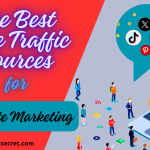Welcome to my article on “SEO for Affiliate Marketing: How to Rank and Bank”. So you’ve started affiliate marketing—congrats! You’ve picked a niche, signed up for a few affiliate programs, and maybe even published your first blog post. Now you’re just sitting back, waiting for that sweet passive income to roll in… right? Except, nothing’s rolling in. Not even tumbleweeds.Here’s the harsh truth: Without traffic, your affiliate links are just expensive bookmarks. And while you could throw cash at ads and pray for clicks, that’s not exactly the definition of passive income. This is where SEO (Search Engine Optimization) comes in—not the sexiest acronym at first glance, but absolutely the secret sauce to making your affiliate site visible, trustworthy, and profitable.
In this guide, we’re diving into how to use SEO to rank your affiliate content on Google and actually bank those commissions. We’ll cover everything from finding the right keywords that scream “buy now,” to crafting content that makes Google—and your audience—fall in love. Plus, we’ll touch on link-building, avoid-the-Google-slap mistakes, and share a few ninja-level tips to outrank the big dogs in your niche. So buckle up. Whether you’re a total newbie or you’ve already wasted three months chasing the wrong keywords, this guide is your roadmap to turning your affiliate site into a traffic-and-commission machine—without selling your soul (or your sanity) in the process. Let’s get ranking. Let’s get banking.
My Best Recommended & Proven Way to Make $100-$300 Daily – Watch This FREE Video to START >>>

Why SEO Is Essential for Affiliate Marketing Success
SEO (Search Engine Optimization) is what gets eyes on your content without you needing to pay for ads, dance on TikTok, or cold-DM strangers on LinkedIn. It’s the engine behind organic traffic—visitors who find your blog or site through Google searches and, if you’ve done things right, click your affiliate links and make you money while you sleep (the dream, right?).
Now, why is SEO particularly important for affiliate marketers? Because unlike eCommerce brands or local businesses, affiliate sites live and die by content visibility. You’re not selling your own product, so you have to out-position the competition by ranking higher in search results. Every rank higher means more eyeballs, and more eyeballs = more clicks = more potential commissions. Math you actually like.
And here’s the best part: SEO has compounding power. A well-optimized blog post can rank for months—or years—bringing in consistent traffic long after you’ve forgotten you even wrote it. No boosting, no refreshing ads, no awkward DMs. Just good, clean, passive magic.
My Best Recommended & Proven Way to Make $100-$300 Daily – Watch This FREE Video to START >>>
But wait, there’s more! (Infomercial voice: intensifies) SEO also builds trust and authority. When users find your content organically in search results, they’re more likely to trust your recommendations—because Google, in all its mysterious algorithmic wisdom, put you there. That trust is gold when your income depends on someone clicking a link and buying something they’ve never seen before.
Bottom line? If you want to turn your affiliate site into a commission-generating machine instead of a ghost town with a few lonely blog posts, you need SEO. Not optional. Not “nice to have.” It’s the fuel that powers the affiliate marketing rocket ship. Or at least helps it get off the launchpad.
Finding Profitable Keywords with Buyer Intent
Now that we’ve established SEO is your affiliate site’s best friend, let’s talk about its secret handshake: keywords. But not just any keywords—we’re after the ones that mean business. Literally.
What you want as an affiliate marketer are keywords with buyer intent. These are the folks who aren’t just browsing—they’ve got their wallet half out and they’re Googling things like:
- “Best protein powder for weight loss”
- “Affordable SEO tools for bloggers”
- “iPhone vs. Samsung for photography”
These people? They’re ready to click. Ready to compare. Ready to buy.
And your job is to show up in front of them before your competitors do.
So how do you find these magical money words?
Start with tools like Google Keyword Planner, Ahrefs, Ubersuggest, or even the old-fashioned “type it in and see what Google auto-suggests.” Look for terms with:
- Moderate search volume (so people are actually looking for it)
- Low to medium competition (because going head-to-head with Amazon on “best headphones” is… ambitious)
- And most importantly: commercial or transactional intent.
Pro tip: Look for keyword modifiers like:
- “Best”
- “Top 10”
- “Cheap”
- “Review”
- “Comparison”
- “Buy”
- “Discount”
These are flashing neon signs that the user is shopping, not just learning.
Also, don’t sleep on long-tail keywords—those 4-5 word phrases like “best affordable DSLR camera for beginners.” They may get less traffic, but they convert like crazy and are easier to rank for.
Find the right keywords, and your affiliate links won’t just sit there collecting dust—they’ll start working overtime while you focus on more important things. Like writing your next post… or watching cat videos. No judgment.
Creating Content That Ranks and Converts
So, you’ve got your buyer-intent keywords in hand. Great. Now what?
Well, now it’s time to do something dangerously underrated in affiliate marketing: create content that doesn’t suck. If you want to rank on Google and actually convince people to click your affiliate links, you need content that checks two boxes:
- It makes Google happy.
- It makes your reader trust you enough to take action.
Let’s break it down.
1. Make Google Fall in Love With Your Content
Google wants to serve helpful, high-quality results. So give the algorithm what it wants:
- Keyword in the title? Check.
- Keyword in the URL and H1 tag? Check.
- Relevant subheadings (H2s and H3s) with natural keyword use? Yup.
- Internal links to your other posts? Bonus points.
- Readable formatting—short paragraphs, bullet points, images, and no walls of text? Chef’s kiss.
Also, don’t forget the meta title and description—those little blurbs that show up in search results. Think of them like your content’s Tinder profile. Make them swipe-right worthy.
2. Make Your Readers Trust You (So They Click)
Here’s the secret: people don’t buy from blogs—they buy from people they trust. Your content should educate, entertain, and gently guide your reader toward a solution… which just so happens to be your affiliate recommendation (what a coincidence!).
A winning structure might look like:
- Hook: Call out the problem or need.
- Value: Give actual, useful info—not just fluff around your affiliate link.
- Recommendation: Offer the best option(s) with honest pros and cons.
- Call to Action (CTA): Tell them exactly what to do next (e.g., “Click here to check the latest price”).
Don’t overstuff with affiliate links. Use them sparingly and with purpose. Think of a trusted advisor, not a shady salesman in a trench coat.
And finally—format matters. Use comparison tables, highlight boxes, and visuals to break things up and emphasize your top picks.
Link Building Strategies That Actually Work
Ah, link building. The part of SEO that everyone loves to hate. It’s like flossing—everyone knows it’s important, most people avoid it, and if you ignore it long enough… things start to fall apart.
But let’s be real—getting links isn’t easy. Especially when you’re not a giant brand or a full-time outreach machine. So here are some link building strategies that actually work (no snake oil involved):
🔗 1. Guest Posting (the OG tactic)
This one still works—if you’re not lazy about it. Reach out to relevant blogs in your niche and offer to write a helpful, non-spammy article in exchange for a backlink. Just don’t send generic emails like, “Dear webmaster, I love your blog about technology/fitness/basket weaving…” Be personal. Be relevant. Be useful.
My Best Recommended & Proven Way to Make $100-$300 Daily – Watch This FREE Video to START >>>
🔗 2. HARO (Help a Reporter Out)
HARO is like speed dating with journalists. Sign up, respond to media requests, and if they quote you—bam! Free backlink from a high-authority site. Plus, it makes you look super credible. Bonus if you can name-drop that Forbes or Business Insider link later.
🔗 3. The Skyscraper Technique
Find a piece of content in your niche that already has a ton of backlinks. Then make something better. Then, reach out to the people linking to the original and say, “Hey, I made this updated version—might be worth linking to?” Classic ego-bait move, but hey—it works.
🔗 4. Resource Page Outreach
Some sites maintain “Best Tools” or “Useful Resources” pages. If your content fits the bill, politely ask to be included. You’ll be surprised how many people say yes, especially if your content genuinely adds value.
🔗 5. Internal Linking (the underrated hero)
Guess what? You control your own site, so use it. Link to your newer affiliate posts from older high-traffic articles. This not only passes authority but helps Google crawl your content more efficiently. Internal linking is like building your own little web—minus the spiders.
Common SEO Mistakes Affiliate Marketers Should Avoid
Alright, you’re almost there—you’ve got your keywords, you’re writing killer content, and you’re even building links like an outreach ninja. But before you go full affiliate rockstar, let’s hit pause and talk about the landmines.
Yes, those sneaky little SEO mistakes that can tank your rankings, confuse your readers, and make Google give you the side-eye.
Let’s break them down so you can dodge them like a pro.
❌ 1. Overstuffing Keywords Like It’s a Thanksgiving Turkey
Once upon a time, cramming your target keyword into every other sentence actually worked. That time is now called “2006.” Today, keyword stuffing doesn’t just make your content unreadable—it tells Google your content is low-quality (and possibly written by a robot with no social skills).
Do this instead: Use your main keyword naturally, sprinkle in a few related terms (a.k.a. LSI keywords), and write like a human who wants to help another human—not game the system.
❌ 2. Thin Content With Zero Value
You know the type: 500-word articles that say “The best microphone is the one that works for you” and call it a day. Google doesn’t like lazy content. Readers like it even less. If your article doesn’t genuinely answer a question or help someone make a decision, why would it rank?
Pro tip: Aim for depth. Cover the topic fully. And yes, actually test or research the products you recommend. Shocking, I know.
❌ 3. Too Many Affiliate Links, Not Enough Trust
Yes, you’re here to make money—we all are. But stuffing 10 affiliate links into the first two paragraphs is a quick way to make your content look spammy and desperate. It’s also a red flag to Google.
Better strategy: Use affiliate links sparingly and contextually. Build up to them with solid info and only link when it actually makes sense. Think advisor, not infomercial host.
❌ 4. Ignoring Site Speed and Mobile Optimization
In the age of TikTok attention spans, if your site takes more than 3 seconds to load, people are bouncing like a superball. Plus, Google ranks mobile-first—so if your site looks like a janky PDF on a phone, you’re in trouble.
Fix this: Use tools like PageSpeed Insights, compress your images, and choose a responsive theme. Your bounce rate (and rankings) will thank you.
❌ 5. Not Disclosing Affiliate Relationships
Transparency isn’t just ethical—it’s the law. The FTC requires you to disclose affiliate links. Plus, being upfront builds trust. Readers are smart. They’ll respect you more if you just say, “Hey, I may earn a commission if you buy through this link. No extra cost to you.”
Add a clear disclosure at the top or bottom of your post (and don’t bury it in 8pt gray font).
Conclusion: Rank Smart, Bank Hard
Affiliate marketing isn’t rocket science—but it is a bit of a balancing act. You need the right mix of strategy, patience, creativity, and a slightly unhealthy obsession with Google Analytics.
Here’s the good news: by focusing on SEO, you’re not just throwing content into the internet void and hoping for clicks—you’re building a long-term traffic engine that keeps working even when you’re binging Netflix or sleeping like a baby with passive income dreams.
My Best Recommended & Proven Way to Make $100-$300 Daily – Watch This FREE Video to START >>>
Let’s recap the money moves:
- SEO is essential if you want traffic that actually converts (and doesn’t cost you your entire ad budget).
- Find buyer-intent keywords—the kind that say “I’m ready to buy, just tell me what button to click.”
- Create content that ranks and persuades—educate first, pitch second, convert always.
- Build quality links without selling your soul or begging strangers on the internet (unless they’re journalists—then beg politely).
- And of course, avoid the classic SEO mistakes that make Google cry and your rankings disappear.
Most importantly? Play the long game. SEO isn’t an overnight get-rich scheme. But with consistent effort, smart strategies, and a little patience, you’ll go from “affiliate hopeful” to “affiliate baller” in no time.
So go forth, optimize, and let your content do the heavy lifting—while you sit back, sip your coffee, and watch those commission emails roll in. Rank smart. Bank hard. And maybe floss once in a while. 🦷💰
Thanks a lot for reading my article on “SEO for Affiliate Marketing: How to Rank and Bank” till the end. Hope you’ve helped. See you with another article.










